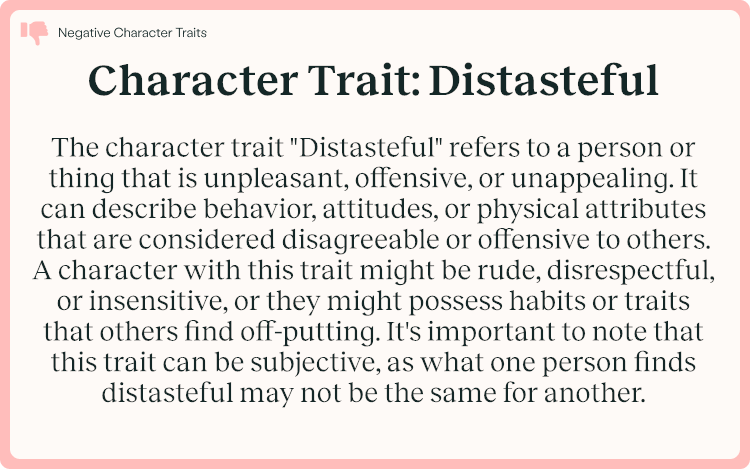
To engage your reader, it's important to always show not tell the traits of your characters. The character trait "Distasteful" refers to a person or thing that is unpleasant, offensive, or unappealing. It can describe behavior, attitudes, or physical attributes that are considered disagreeable or offensive to others. A character with this trait might be rude, disrespectful, or insensitive, or they might possess habits or traits that others find off-putting. It's important to note that this trait can be subjective, as what one person finds distasteful may not be the same for another.
- Possible causes of being distasteful
- Behaviors associated with being distasteful
- Attitudes associated with being distasteful
- Thoughts and struggles associated with being distasteful
- Emotions associated with being distasteful
- Facial expressions associated with being distasteful
- Body language associated with being distasteful
- Behaviors associated with being distasteful
- Growth and evolution of distasteful characters
- Stereotypes of distasteful characters to avoid
- Negatives of being distasteful
- Positives of being distasteful
- Verbal expressions of distasteful characters
- Relationships of distasteful characters
- Examples from books of characters who are distasteful
- Writing exercises for writing distasteful characters
Possible causes of being distasteful
You might want to weave these into your character's back story to build a more believable character.
- Arrogance or a sense of superiority
- Resentment or bitterness towards others
- Mental health issues such as depression, anxiety, or personality disorders
- Substance abuse or addiction
- Negative past experiences or trauma
- Habitual negative thinking or behavior
- Insecurity or low self-esteem
- Lack of self-awareness or introspection
- Lack of empathy or compassion for others
Behaviors associated with being distasteful
You may be able to show your character's trait of distasteful by using these.
- Disregarding others' feelings or opinions
- Failing to take responsibility for one's actions or mistakes
- Acting in a dishonest or deceitful manner towards others
- Making offensive or insensitive comments or jokes
- Speaking rudely or disrespectfully to others
- Being selfish or self-centered in interactions with others
- Being judgmental or critical of others without reason
- Acting arrogantly or condescendingly towards others
- Refusing to try new things or be open-minded
Attitudes associated with being distasteful
You may be able to show distasteful through their attitudes.
- Indignation
- Disrespectfulness
- Insensitivity
- Hostility
- Antagonism
- Rudeness
- Arrogance
- Contemptuousness
- Disdainfulness
Thoughts and struggles associated with being distasteful
Here are some ideas for things your distasteful character may think or struggle with.
- They may struggle with addiction or other destructive behaviors, such as substance abuse or gambling.
- A Distasteful character may struggle with a sense of superiority over others, believing that they are better than everyone else.
- They may have a lack of empathy or concern for others, viewing them as pawns to be used for their own gain.
- They may have a cynical or negative view of the world, seeing everything as inherently flawed or corrupt.
- They may have a deep-seated fear of vulnerability or intimacy, and may struggle to form genuine connections with others.
- They may struggle with anger or resentment towards others, feeling that they have been wronged or slighted in some way.
- They may have a tendency to manipulate or deceive others in order to get what they want.
Emotions associated with being distasteful
Here are some ideas for emotions your distasteful character may experience.
- Displeasure
- Abhorrence
- Revulsion
- Aversion
- Disgust
- Antipathy
- Nausea
Facial expressions associated with being distasteful
Here are some facial expressions your distasteful character may exhibit.
- Raised eyebrows with a downward slant
- Curling of the lips
- Twitching of the nose
- Sneering
- Frowning
- Grimacing
- Narrowing of the eyes
- Clenched jaw
- Rolling the eyes
Body language associated with being distasteful
Here is some body language your distasteful character may exhibit.
- Clenched jaw or gritted teeth
- Covering the mouth or nose with a hand or tissue
- Curling the lip or nose in disgust
- Scrunching up the face or wrinkling the forehead
- Shaking the head or rolling the eyes
- Frowning or scowling
- Narrowing the eyes or looking away
- Crossing the arms or turning away from the source of the distastefulness
Behaviors associated with being distasteful
Here are some behaviors your distasteful character may exhibit.
- Refusing to try new things or be open-minded
- Making offensive or insensitive comments or jokes
- Speaking rudely or disrespectfully to others
- Acting arrogantly or condescendingly towards others
- Being judgmental or critical of others without reason
- Being selfish or self-centered in interactions with others
- Failing to take responsibility for one's actions or mistakes
- Disregarding others' feelings or opinions
- Acting in a dishonest or deceitful manner towards others
Growth and evolution of distasteful characters
Here are some ways that your distasteful character may grow and evolve over time.
- Building empathy towards others and becoming more considerate and compassionate
- Engaging in self-reflection and introspection to understand the root of their distasteful behavior
- Acknowledging their negative traits and behaviors
- Making efforts to change their behavior and attitudes towards others
- Accepting responsibility for their actions and their impact on others
- Seeking help or guidance from others to overcome their flaws
- Developing new skills and interests that challenge their negative tendencies
- Learning from their mistakes and experiences to improve themselves
Stereotypes of distasteful characters to avoid
Try to avoid writing stereotypical distasteful character like these examples.
- Avoid making Distasteful characters solely motivated by greed or power without exploring deeper motivations or backstories.
- Avoid making Distasteful characters too perfect or flawless, as this can make them unrealistic and unrelatable.
- Avoid making Distasteful characters overly aggressive or violent without proper motivations or reasons.
- Avoid making Distasteful characters one-dimensional or purely evil with no redeeming qualities.
- Avoid using harmful stereotypes such as associating a certain race or gender with a Distasteful trait.
- Avoid portraying Distasteful characters as mentally ill or psychotic without proper research and sensitivity.
Negatives of being distasteful
Here are some potential negatives of being distasteful. Note: These are subjective and some might also be seen as positives depending on the context.
- Missing out on opportunities due to a negative reputation.
- Damaging one's own mental and emotional well-being.
- Hindering social interactions and relationships.
- Being perceived as untrustworthy or unethical.
- Alienating others and creating a sense of discomfort.
- Coming across as rude, insensitive, or offensive.
- Limiting personal growth and development.
- Inviting conflict and confrontation.
Positives of being distasteful
Here are some potential positives of being distasteful. Note: These are subjective and some might also be seen as negatives depending on the context.
- They can be used to explore themes such as morality, ethics, and the consequences of one's actions.
- Distasteful characters can be relatable, as we all have flaws and make mistakes. Seeing a character struggle with their own flaws can be both cathartic and inspiring.
- Distasteful characters can also serve as a foil for other characters, highlighting their strengths and virtues.
- Distasteful characters can be very memorable, as their actions and behavior can be shocking or unexpected.
- They can be used to create tension and conflict, as their behavior may clash with the values of other characters.
- They can be used to challenge stereotypes and societal norms, as they may defy expectations and offer a fresh perspective.
- Distasteful characters can add complexity and depth to a story, making it more interesting for the reader.
Verbal expressions of distasteful characters
Here are some potential expressions used by distasteful characters.
- Crude language
- Rude comments
- Offensive jokes
- Vulgar language
- Insulting remarks
- Harsh criticism
- Inappropriate remarks
- Disrespectful tone
- Hurtful comments
Relationships of distasteful characters
Here are some ways that being distasteful could affect your character's relationships.
- They may be selfish or self-centered, putting their own needs and desires above those of others and showing little consideration or compassion.
- A distasteful person may have a tendency to dominate or control their relationships, often belittling or dismissing the opinions and feelings of others.
- They may be confrontational or aggressive, often picking fights or starting arguments over minor issues.
- They may be deceitful or dishonest, lying or misleading others for their own benefit or to avoid taking responsibility for their actions.
- They may be dismissive or indifferent to the needs and feelings of others, showing little empathy or concern for the well-being of those around them.
- They may be judgmental or critical, constantly finding fault with others and making them feel inadequate or inferior.
- They may be manipulative, using guilt or emotional blackmail to get what they want from others.
Examples from books of characters who are distasteful
- Dolores Umbridge from "Harry Potter and the Order of Phoenix" by J.K. Rowling
- Nurse Ratched from "One Flew Over the Cuckoo's Nest" by Ken Kesey
- Patrick Bateman from "American Psycho" by Bret Easton Ellis
- Humbert Humbert from "Lolita" by Vladimir Nabokov
- Iago from "Othello" by William Shakespeare
- Cathy Ames from "East of Eden" by John Steinbeck
- Holden Caulfield from "The Catcher in the Rye" by J.D. Salinger
- Amy Dunne from "Gone Girl" by Gillian Flynn
- Alex from "A Clockwork Orange" by Anthony Burgess
Writing exercises for writing distasteful characters
Here are some writing exercises you might try for learning to write distasteful characters.
- Consider how the distasteful trait might manifest in different contexts or situations. Write a scene where your character is forced to confront their negative trait in a way that challenges them to grow or change.
- Write a scene from the perspective of a character who is negatively affected by your distasteful character's behavior. How does the distasteful trait impact their relationship?
- Start by brainstorming a list of possible traits that could be considered distasteful (e.g. arrogance, selfishness, dishonesty, etc.)
- Write a scene from the perspective of the distasteful character themselves. Try to show the internal struggle they might experience as a result of their negative trait.
- Write a monologue or internal dialogue from the distasteful character's point of view, exploring the reasons behind their behavior and attitudes.
- Choose one of these traits and create a character who embodies it. Think about how this trait informs their behavior, thoughts, and interactions with others.
